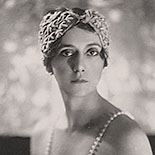 Ida Lvovna Rubinstein (October 5, 1883 – September 20, 1960) was a Russian ballet dancer, actress, patron and Belle Époque figure.
Ida Lvovna Rubinstein (October 5, 1883 – September 20, 1960) was a Russian ballet dancer, actress, patron and Belle Époque figure.
Rubinshtein was born into one of Russia’s richest families. Ida’s grandfather, Ruvim (Roman) Rubinshtein, had been a successful sugar trader in Kharkov. He moved to Saint Petersburg, where he founded the company, Roman Rubinshtein & Sons, with his two sons, Lev (Leon) and Adolf (Anton). The family multiplied their investment many times over, becoming millionaires by the time Ida was born. The family expanded to own several banks (including the First Bank of Kharkov), sugar mills and breweries.
Her mother died when Ida was very young, and in 1892, her father died in Frankfurt, leaving her a vast fortune. In 1893, the 8-year-old Ida was sent to Saint Petersburg to live with her aunt, socialite “Madame” Gorvits (Horwitz). Rubinshtein grew up in her aunt’s mansion on the city’s famed Promenade des Anglais, where she was given the best education. She became fluent in English, French, German and Italian. When she became interested in Ancient Greece, a Greek professor was invited to tutor her in Saint Petersburg.
 Rubinshtein is not considered to be in the top tier of ballerinas; she began her training too late for that to have been a possibility. She did, however, have tremendous stage presence and was able to act. She was also a significant patron and she tended to commission works that suited her abilities, works that mixed dance with drama and stagecraft. In 1934, the French government awarded her the Légion d’honneur, and then in 1939 the Grand Cross of the Légion, its highest honor. In 1935, she was awarded honorary French citizenship, and in 1936 she converted to Roman Catholicism.
Rubinshtein is not considered to be in the top tier of ballerinas; she began her training too late for that to have been a possibility. She did, however, have tremendous stage presence and was able to act. She was also a significant patron and she tended to commission works that suited her abilities, works that mixed dance with drama and stagecraft. In 1934, the French government awarded her the Légion d’honneur, and then in 1939 the Grand Cross of the Légion, its highest honor. In 1935, she was awarded honorary French citizenship, and in 1936 she converted to Roman Catholicism.
In 1940, she left France during the German invasion, and made her way to England via Algeria and Morocco. There she helped wounded Free French soldiers until 1944. Walter Guinness (later Lord Moyne), her long-term lover and sponsor, remained supportive, providing a suite at the Ritz Hotel, until he was assassinated by the Stern Gang in late 1944. She returned to France after the war, living finally at Les Olivades at Vence.
Bisexual, in 1911, Rubinshtein began a three-year affair with the artist Romaine Brooks, who created a striking portrait. She used the dancer as a nude model for Venus.